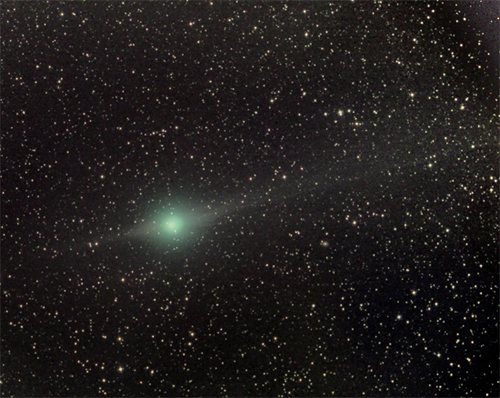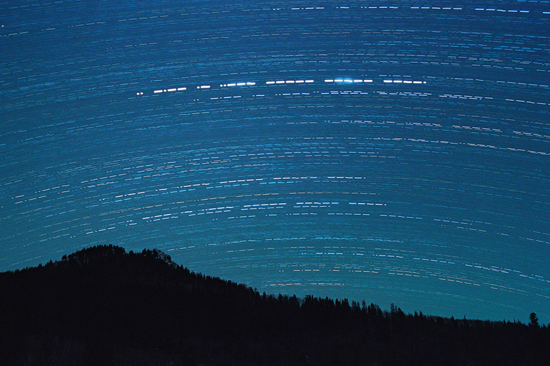IYA2009 Updates
IYA2009 News Round-up, 6 February
6 February 2009
News, glorious news!
IYA2009 has an official patron, Dr. Mani Bhaumik. This talented individual is helping IYA2009 to achieve its aims and his appointment has not gone unnoticed, as IBN Live, Mangalorean.com, The Times of India, Thaindian News and Nhatky.in report.
Here's one for all you keen amateur astronomers: Comet Lulin is getting ever-brighter in the night sky, and is attracting some deserving attention. Let's give a shout-out to IYA2009.com which has a short article with some useful maps outlining where to locate this object. Perhaps the author was inspired by the IYA2009 site update.
Astronomers are often asked why studying the heavens is beneficial to society. Business Daily Africa has written about the sometimes overlooked but very important economic benefits of astronomy, and claims that countries that don't invest are missing out.
Stamp collecting astronomy enthusiasts will be pleased to hear that a plethora of themed stamps will be released during 2009, commemorating our favourite branch of science. For a sneak-preview of what to expect, head on over to the Rainbow Stamp Club.
The Christian Science Monitor has given a mention to both IYA2009 and the 200th birthday of Charles Darwin. This has also been noticed by Open Parachute, who go one better by putting the logo next to the text. Thanks!
And finally, what has IYA2009 got to do with the Dewey Decimal Classification System? Only one site dares answer that: The Dewey blog!
IYA2009 ToolBar for Internet Explorer and Firefox
4 February 2009
Comet Lulin: one to watch in 2009
4 February 2009

The bright Comet Lulin is expected to put on an excellent show in our night skies this month. It is easily visible in binoculars, and sharp-eyed observers may even be able to spot it with unaided eyes, if conditions are favourable. Estimates suggest it will be brightest around 24 February, when it will also appear to pass close to the planet Saturn.
For more information about Comet Lulin, along with charts of where to find it in the sky, check Sky and Telescope's webpage:
http://www.skyandtelescope.com/observing/highlights/35992534.html
Image Caption: Comet Lulin on February 2nd, glowing at magnitude 6.5 with tail and antitail. Credit: Paolo Candy (http://www.hesnet.net/candy/)
Spanish IYA2009 Promotional Spot
3 February 2009
Check the Spanish IYA2009 Promotional Spot in 5 different languages:
http://www.astronomia2009.cat/bin/view/Main/PaginaVideosENG
In English: http://www.astronomy2009.org/resources/multimedia/videos/detail/iya2009_es_video/
News Round-up, 30 January 2009
30 January 2009
It's Friday! The week is almost over, and two days of relaxation are imminent. But not before the weekly IYA2009 news round-up!
The big news story this week was NASA announcing that members of the public can vote for an object to be imaged by the Hubble Space Telescope during 100 Hours of Astronomy. Predictably this story has been picked up by many sites, including Discovery, Fox News, About.com, Aero-News, Examiner, iTWire, and countless others. Even more coverage can be expected during 100 Hours.
Our very own New Media Task Group Chair Pamela Gay was the subject of a story on DenNews.com. Pamela gave an amateur astronomy lecture titled "The Once and Future Role of Citizen Science: The Great Discoveries of Public Astronomers Across History" and impressed those in attendance.
MSNBC.com contributor Dan Roach has put together an informative article about From Earth To The Universe. Spanning ten pages, it shows a healthy sample of FETTU images, along with captions. It's a good taster of FETTU. Seed Magazine have done something similar, albeit with a snazzier interface.
GizMag mentions IYA2009 in the very first sentence of its article about the work of Thomas Harriot and Galileo Galilei. It describes how some historians believe that Harriot may have beaten Galileo by observing sights through a telescope first, and even created excellent maps of the Moon.
The ever-popular Astronomy Picture of the Day adopted an IYA2009-themed image this week. It was mentioned on the Cosmic Diary, and everything.
And finally, a quick plug for the excellent (and free) Communicating Astronomy with the Public Journal, which has just released issue five. Read, and be impressed. That's an order.
Lee Pullen
IYA2009 Staff Writer
Ten views: From Earth to the Universe on msnbc.com
28 January 2009
Ten views: From Earth to the Universe
News round-up, 23 January 2009
23 January 2009
Welcome to the third IYA2009 round-up, where we take a whistle-stop tour of news coverage from the world of cyberspace.
Waves from the IYA2009 Opening Ceremony are still being felt, and this report courtesy of the US node contains some interesting information, including mentions of the Galileoscope project and the documentary production BLAST!
The Oklahoma Daily has dedicated a few paragraphs to local news about the Year, pointing out an upcoming series of astronomy lectures at the Sam Noble Oklahoma Museum of Natural History, followed by public observing sessions using telescopes. A similar situation is occurring in Clanfield Observatory, reports the UK's Portsmouth Today site. The author says that the events will coincide with "the first International Year of Astronomy". There's going to be another? Yay!
For those telescope-buffs out there, you may like to read the Popular Mechanics article about the most powerful telescopes today, as well as a sneak-preview of the future of giant observatories.
Inquirer.net published a good article about IYA2009 from a Filipino-perspective, and is noteworthy for containing a section on how light pollution not only disrupts our view of the stars, but also stresses ecological systems.
A Johannesburg site has a feature on the upcoming solar eclipse that will be visible from South Africa. Where to go and how to safely view it are outlined. Note the banner image, which appears to be a photo of a photo. Australia's South Western Times also discusses the eclipse, and suggests using a pinhole camera to observe it.
A short but interesting story was recounted by The Guardian about scientists trying to conduct genetic testing on the remains of Galileo, with the aim of learning more about his poor eyesight, and whether that influenced the observations he made. The article politely mentions IYA2009 at the very very end.
CNW Telbec reports that The Montréal Planetarium will be celebrating IYA2009 in style, by hosting a great number of events. Astronomers will be taking their shows beyond the planetarium doors to local parks, guaranteeing a greater number of people will learn about our Universe. Over 70 events have been planned, including observing sessions, contests, workshops and discussions.
And last but not least, Gerard van Belle's blog on the Cosmic Diary has announced a major development in the world of astronomy: the European Southern Observatory HQ's coffee machine has broken down. Until it's fixed, the world's scientific output will be severely hampered. Let's hope it's repaired double-time!
Lee Pullen
IYA2009 Staff Writer
Sirius sings for IYA2009
23 January 2009

Astronomy professor and astrophotographer Jimmy Westlake decided to do something special to mark IYA2009: send a message from the stars!
Taking a long exposure of the bright star Sirius, he blocked the light at specific times by placing his hand over the lens. The resulting dot-dash pattern spells out a message in International Morse Code.
Click here for a chart, and see if you can decipher the code. Scroll down for the answer.
So what does it say?
.. -.-- .- ..--- ----- ----- ----.
I Y A 2 0 0 9
Says Jimmy, "The total duration of the exposure was just under two hours: 117.5 minutes long. The ‘shutter' creating the gaps was my shivering, gloved hand held over the lens in the 0ºF Colorado air. Every few minutes, I had to turn on a blow dryer to keep the frost from forming on the lens (and me!)"
Congratulations go to Jimmy for his imaginative way of spreading the message of IYA2009.
Hi-Res Image: http://www.astronomy2009.org/resources/multimedia/images/detail/sirius_iya2009/
News Round-up, 19 January 2009
19 January 2009
Hello and welcome to the second news round-up! It's been an exciting week for IYA2009, in no small part because of the official Opening Ceremony in Paris. Not unexpectedly, this event was reported by many outlets. Innovations Report, Kansas City info Zine (with focus on the National Science Foundation's contributions), OneIndia, Space.Ref.com, and Kazakhstan-based Kazinform are examples of the international coverage that the Opening Ceremony attained. Of course, this is just a sample; there are countless more mentions on other websites and blogs in cyberspace. And I'd be remiss if I didn't mention the Cosmic Diary LiveBlog, which contains on-the-scenes accounts of the event, and photos to accompany the text.
In other news, The Philadelphia Inquirer has run an article outlining upcoming developments in the world of big telescopes. 400 years after Galileo's first observations, the technology we have is incredible. A well-written overview of the Year has been provided by The Skeptic Detective, which promises to post updates when new astronomical discoveries are made. And Hannah Lally from The Wire has produced an article about IYA2009, which features opinions from astronomers and astronomy communicators. It's well worth a read.
Kent News in the UK has run a story about events occurring in that part of the world, particularly during an opening ceremony on 20 January. The article contains some good quotes from Prof. Michael Smith, the local coordinator.
The Westmoreland Gazette talks about light pollution, and how it can obscure valuable views of the heavens. It includes the lovely closing line "This year, the sky is definitely not the limit. " There's also mention of light pollution on the NZCity, which reports that there is a push for an area in New Zealand to become a night sky reserve. And excellent news from AboutMyArea, which says that the Exmoor (UK) National Park Authority has been awarded £3500 from the Royal Astronomical Society in support of IYA2009 and dark sky programmes. These will occur throughout the year, so keep an eye out for them if you happen to live in that part of the world.
Until next week, continue celebrating IYA2009, and fingers crossed for clear skies!
Lee Pullen
IYA2009 Staff Writer
History and IYA2009: working together to benefit astronomy
19 January 2009
The IYA2009 Secretariat is happy to inform that as of today, History is the exclusive international television partner of the IYA2009. This partnership aligns with the IYA2009 Secretariat's objectives of increasing the visibility and maximizing the reach of the IYA2009, reaching large audiences and key markets around the world.
As a IYA2009 Media Partner, History will contribute to promoting IYA2009 and raise awareness of its global activities and events. This support will come in the form of promotion clips and interstitials that will be aired throughout 2009, as well as a special attention given to astronomy related programming in all History channels and special IYA2009 events.
We expect that the partnership agreement now signed between the IYA2009 Secretariat and History will also be very useful for the communication strategy of our national nodes. We therefore encourage the IYA2009 National Nodes to contact the national and regional History delegations and seek similar partnerships. The list of contacts can be found here: http://www.historychannel.tv/
Search IYA2009 Updates

National Nodes: 148
Organisational Nodes: 40
Organisational Associates:33
National Websites: 111
Cornerstone Projects: 12
Special Task Groups: 11
Special Projects:16
Official Products:8
Media Partners:22


